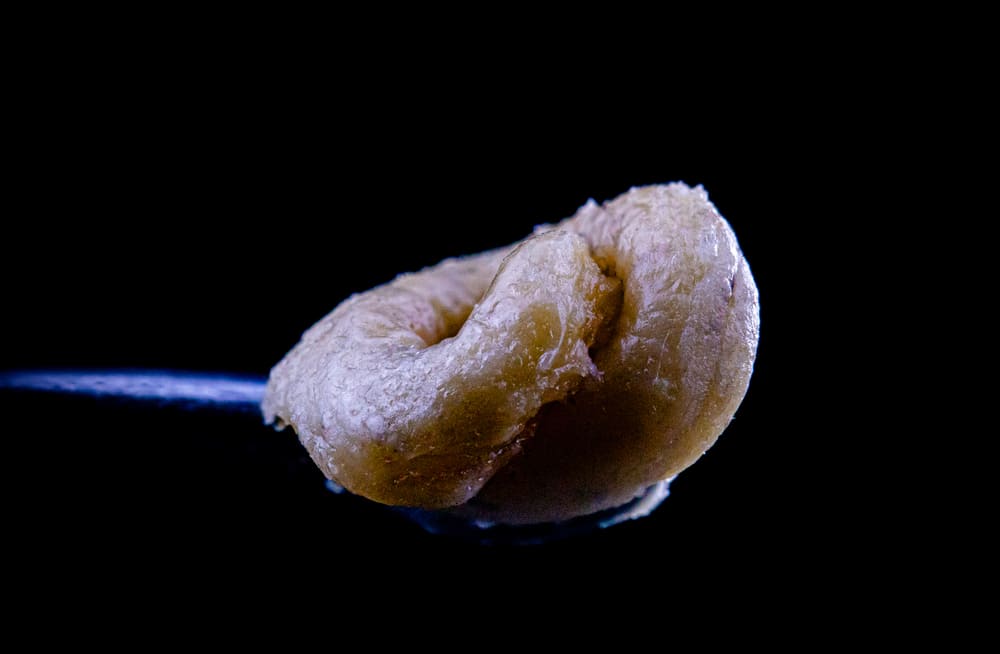Check out Jimbo's video on creating flower rosin!
If you tuned in for part one of this series then you’ve now got an understanding and appreciation for the history and advantages of making flower rosin with your homegrown autoflowers. In this second instalment, we are going to go over the equipment required to make flower rosin at home. Fear not, it is not necessary to have an expensive arsenal of cutting-edge technology on hand. All you need is a few household tools, and you can get started fairly effortlessly. Let’s get into it!

Equipment Required to make Flower Rosin:
A Rosin Press
As we discussed in Part 1, flower rosin can be made by using a combination of heat and pressure to extract and concentrate the contents within the trichomes that cover our freshly harvested plants. Our first and most important tool in the process of making flower rosin is a piece of equipment capable of providing the heat and pressure necessary to make that extraction possible. As far as terminology goes, we call these pieces of equipment presses. Here are a few examples of rosin presses:
- Hair Straightener
Prior to the summer of 2015, there was no market for rosin presses. This was back before companies in the rosin press manufacturing game like Low Temp Industries or Pure Pressure began popping up on the market. When this technique hit the scene way back then, early adopters used hair straighteners as their presses. By using brands of hair straighteners with lower temperature settings, you are able to make rosin by briefly pressing a nugget in between a fold of parchment paper using whatever pressure you can muster. We will discuss the details of this rudimentary rosin-making method in our technique section, but due to the high temperature and relatively low pressure, the key to getting a usable product is to press in shorter intervals.
Hair straighteners are just as viable of an option today for making small batches of flower rosin as they were when this method was first introduced. This is a great introductory tool for those who have less experience with concentrates or for those who want to test a flower for yield before stuffing a bunch of bags and potentially creating waste by pressing something that won't yield. If this is your first time making rosin, a hair straightener is going to be the lowest barrier to entry for price and process.
One of the disadvantages to using a hair straightener is that these products were not designed to function in this way. We are adapting a household beauty product to our needs. We will need to be mindful that the hair straighteners we use are electric appliances and should be treated with the utmost caution. If you aren’t careful, you risk being burned or electrocuted. That being said, a bit of caution and good technique will go a long way in preventing unwanted calamities. One thing we can do to help our cause is to choose a hair straightener that comes with lower heat settings. Look for something in the low 300f if possible. Do not opt for a straightener that presses with temps exceeding 450f as this will completely destroy your buds.
Another disadvantage to using a hair straightener is that this technique does not scale well at all. In fact, you really don’t want to heat up your straightener all of the way in the first place. Once the plates are hot enough, the quality of your product will suffer, even with short pressing intervals. Optimal flower rosin presses with a hair straightener are only achievable in the first few minutes after powering your unit on.
- Modified Hat Presses
One of the first conversions to hit the rosin market were modified hat presses. With these, the technology already existed for a unit that could provide a much more stable temperature control while also providing a great deal more pressure than what one could achieve with a hair straightener. Unlike most standard hat presses which only contain one heated plate and component, these modified presses double up on the heat plate to provide full coverage to flower rosin. D-Nail, a company that was known at the time to make electronic dabbing nails, gave their crack at the modified press with their summer 2015 D-Nail Prototype Rosin Press release. Many of these clone presses would pop up to saturate the market in the interim between the D-Nail press release and when more advanced solutions began to make waves.
Aside from the better heat and pressure controls that modified hat presses afford, this option allows rosin makers the ability to scale their production a bit further. While not the most efficient option overall, these presses are able to maintain heat settings so that producers can run multiple samples through over more than one press.
A disadvantage to the modified hat press is that the pressure lever is mechanical and thus offers a lower PSI (pressure per square inch). Typically these hat presses won't exceed 500lbs of pressure. We will discuss the relationship between heat, pressure, and press time in PART 3 of this series. In short, the less pressure you have the more heat you’ll need to apply to achieve a solid yield with your press. The balance here is that higher heat further degrades the biomedical components in rosin. At certain temperatures, certain compounds will degrade, compromising the final product. While hair straighteners typically offer the least desirable heat settings of >300f, modified hat presses can work in the low 200s. Less heat means less loss of quality.
- DIY Presses
Before the market for home grower accessible (affordable) rosin presses began to really mature, the community laid out some solid groundwork for making DIY rosin presses. As opposed to existing tech such as hair straighteners, many of these presses involved sourcing various pre-fabricated components and then self-assembling them to fashion a press from. The same heaters, coils, and hot plates used to modify hat presses could be bought independently and then used to produce much more heavy-duty presses.
Shop presses became the most popular DIY blueprint dude to a combination of their ability to generate high PSI and their simplicity in being able to modify into a DIY rosin press. After a while, one could go online and produce a simple kit that you could pair with a Harbor Freight Shop press from the local hardware store and make themselves at home.
The downside to making DIY presses is that there is a bit of a learning curb and you’ll need to source a lot of this stuff independently. The upside is you can save some coin if you do it right and build a press that's comparable to some of the best on the market today for cheap.
- Hydraulic and Pneumatic Presses
In many ways, the DIY community inspired some of the great rosin press companies of this era to produce similar tools for makers. Rosin press systems almost exclusively using the same physical components today that their DIY counterparts contained years ago can be purchased online in complete packages now. Among those, the most popular press styles are still hydraulic and pneumatic presses. They offer that same high PSI you could build out in a conversion, only with much better controls and functionality (depending on on what units you get).
The advantage to buying complete hydraulic and pneumatic presses is that the units are contained and pre-built. These are, for the most part, plug-and-play devices. There is such a minimal learning curb to an introductory hydraulic rosin press that the instruction manuals to come with them are often printed on single 5x7 cardboard. You turn them on, configure your heat, prepare your sample, press & release, Boom! You’re done!
A disadvantage to buying a complete unit is that you are also baking the craftsmanship and labor of the build into the process point. AKA these rosin presses can get expensive. Initially, their price point was so high that average hobbyist rosin makers couldn’t break the barrier to entry. We are at a point today, however, where prices have dropped significantly. You can buy a decent entree-level 4-Ton press for less than $300.

Other Tools Required for Making Flower Rosin
If you are dedicated to the idea of getting started making flower rosin, you’ll need a few more tools at the ready aside from your press of choice. Here are the most important things you’ll need on hand:
- Unbleached Parchment Paper
No matter what press you choose, parchment paper is pretty essential for making rosin. Opt for unbleached parchment, you don’t want bleach leeching into your final product. You’ll need parchment for pressing, but this paper also makes for a good safe surface to manipulate your final product or even prepare your press beforehand. Have a few rolls of this stuff on hand because it goes quickly.
Note: You don’t want to store rosin in your parchment for long periods of time. Even unbleached parchment paper can leech when exposed to some of the volatile compounds in concentrated rosin.
2. A Collection Tool
Just as important as having parchment on hand is a solid tool for rosin collection. You’ll need something that you can use to stick the fresh rosin to that is both functional and practical. Collecting rosin can be done using a few techniques, so make sure you get a tool that is most conducive to the tech that you decide to go with. Lots of companies carry their own proprietary tools, but don’t be afraid to just grab a titanium dabber tool as well. Ballpoint and flathead tools both work great, although ball points roll better initially.
3. A Cold Surface
Often times flower rosin becomes goopy and viscous right after being removed from the press. This can make collection next to impossible. Your best friend in combatting that is a cold surface to rest your parchment on while you collect. The rapid cooling will solidify your rosin samples, making them manipulatable. This way you can come in with your tool and quickly snap or roll while collecting a much more manageable consistency. Ice packs work great as a cold surface, although you can stick anything into a freezer a get it cold enough within an hour or two that you’d be able to use if for collection.
4. Glass Storage Jars
Doubling down, you do not want to store your flower rosin (or any concentrate) in parchment for extended periods of time. Same thing goes for silicone. The essential oils found in cannabis and subsequently concentrated within rosin have the potential to cause these materials to leech contaminants into your products. Glass jars are the most optimal storage option for concentrates as they present virtually zero risk of contamination. There are other specialized jars out there being used, but glass is accessible
5. Rosin Bags
Once you move into the high-pressure rosin press ranges, it is highly recommended that you use rosin bags. These fine mesh baggies were specifically designed to protect your rosin from the plant contaminants from which it came from. Without bags, pistils, leaf material, and any other number of pollutants can mix in with your rosin. At high pressure, you really want to have a bag there to ensure that the final product is as clean as possible.
Rosin bags come in a number of shapes and mesh/micron sizes. You’ll want to pick up bags that fit within the parameters of your press plates. As far as mesh/micron sizes, this will depend on a few factors. Those include whether you intend to press flower or hash, as well as the varietal you decide to press. Because trichomes on plants differ in shape, size, and composition, some plants will produce a higher or lower yield or even a different consistency based on bag preference. We will discuss this more in our technique section.
6. Pre-Press Molds
An optional tool that is sometimes used for a few rosin pressing techniques is what is known as a “pre-press mold.” These prefabricated molds will partially compress your flowers so that they create fewer gaps within the rosin bag, thus ensuring rosin crosses through the mesh barrier onto the parchment paper. Loose flower risks getting stuck in the nooks behind the mesh during a press, rendering it unrecoverable in the collection process.
Not all press techniques utilize these molds, so make sure you know which one you intend to use before picking one up. They are not at all necessary but can be extremely helpful, especially for pressing higher quantities of material.
Stay tuned for PART 3 where we discuss the most popular techniques for pressing flower rosin.
Jimbo, signing out!
related blogs.
Check out these other blog articles.










